About
Special News
Logan's Page
Jacoby's Page
Our Travel Index
Tracks Ahead Related Trips
Contact
Greece to Turkey Cruise - 2010
Athens to Istanbul
 |
The Star, of the Windstar Cruise Line fleet. This was our transportation between Athens and Istanbul. With only 145 people, it was much more relaxing than the large ships! |
September 1/2
We were out of the house this morning, under rainy skies. Barb and I hustled over to John & Diana’s, where the shuttle driver picked us up right on time, and got us to O’Hare Field with time to spare. We did a curbside check in to avoid the inside hassles, and got to the gate to find – surprise – our flight delayed by about an hour. Ultimately this would not pose a problem, as we were able to make up the lost time on our ten plus hour flight. The plane, a Delta 767-300ER was relatively comfortable, with touch screens in the headrests, and ample entertainment. The legroom was less than wonderful, and it makes we really consider flying business class. Barb and I are getting too old to play contortionist in tiny seats. Plus, the guy in front of me talked pretty much non-stop for the ten hours. And he has, shall we say, a rather commanding voice. Like you could hear it in outer space! If he wasn’t playing Mystery Science Theater 3000 with each and every film he watched, he was complaining to his wife about getting written up by his supervisor (a woman!) for some indiscretion. Even my super Shure ear-buds and new age spa music was hardly enough to mask him. And I did think of several very inventive ways to kill him. However, at the end of the day, the four intrepid travelers are off once again.
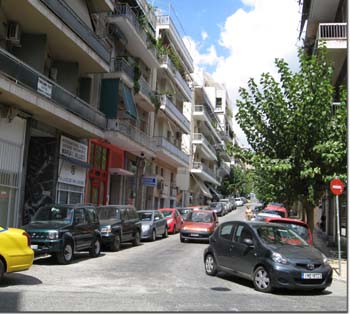 Athens
has a population of about 4 million people and is a sprawling city,
white under the Aegean sun. Residents of Athens represent just
under half of the eleven million Grecian population. We were met
by the transfer service, and driven on about a 45 minute run into town.
It is obvious that much of the infrastructure was put up for the
Olympics in 2004. The roads are smooth and the tunnels numerous.
We checked into the Divani Acropolis Hotel, in the shadow of the
Parthenon, and headed down to a street café for a light lunch.
European cities were characterized by loads of bicycles. Here the
choice is motorcycles or scooters. The streets are narrow, traffic
heavy, and parking appears to a nightmare. Frankly, I crashed for
a couple of hours, and then we ate dinner at the rooftop restaurant here
at the hotel.
Athens
has a population of about 4 million people and is a sprawling city,
white under the Aegean sun. Residents of Athens represent just
under half of the eleven million Grecian population. We were met
by the transfer service, and driven on about a 45 minute run into town.
It is obvious that much of the infrastructure was put up for the
Olympics in 2004. The roads are smooth and the tunnels numerous.
We checked into the Divani Acropolis Hotel, in the shadow of the
Parthenon, and headed down to a street café for a light lunch.
European cities were characterized by loads of bicycles. Here the
choice is motorcycles or scooters. The streets are narrow, traffic
heavy, and parking appears to a nightmare. Frankly, I crashed for
a couple of hours, and then we ate dinner at the rooftop restaurant here
at the hotel. 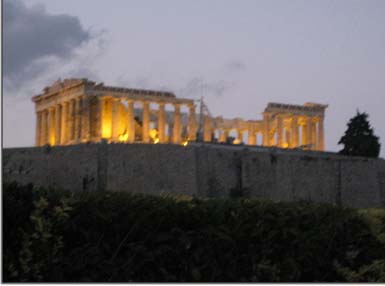
And there was the Parthenon – lighted, and looking just like a picture postcard. Of note, as in most Mediterranean countries, people dine late. I think the desk clerk was most amused at our 8 PM reservation. The food was good, the temperature perfect, and sights spectacular. Tomorrow we start our tour in earnest.
September 3
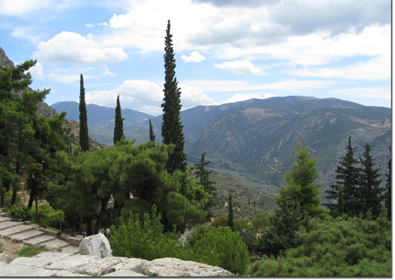 We
met Babas, our day guide and his driver right at 0830, and headed out of
the center of Athens for a two and a half hour trip to Delphi. We
left the city valley and quickly got into the mountains. Delphi is
an area about 75 miles north west of Athens. It was here where the
Oracle of Delphi, the high priestess of wisdom, would dispense
prophecies for visitors.
We
met Babas, our day guide and his driver right at 0830, and headed out of
the center of Athens for a two and a half hour trip to Delphi. We
left the city valley and quickly got into the mountains. Delphi is
an area about 75 miles north west of Athens. It was here where the
Oracle of Delphi, the high priestess of wisdom, would dispense
prophecies for visitors.
First a little
background. The priestess was an older woman,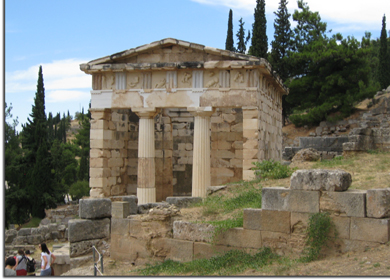 usually over 50 years of age, which was pretty old for the time.
The whole thing started when a woman noticed that her sheep would act
strangely around a certain area in the mountains. She too was
affected by escaping subterranean gasses, which lead to a trance state.
The individual would then start speaking in another language, or the
"Language of the Gods." For what else could explain such an event?
usually over 50 years of age, which was pretty old for the time.
The whole thing started when a woman noticed that her sheep would act
strangely around a certain area in the mountains. She too was
affected by escaping subterranean gasses, which lead to a trance state.
The individual would then start speaking in another language, or the
"Language of the Gods." For what else could explain such an event?
Gradually a temple
grew up over this
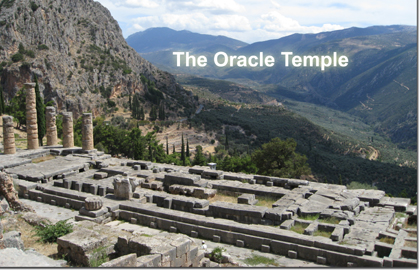 spot.
Situated high in the mountains, the temple underwent several builds and
rebuilds due to seismic activity and a landslide that took out a lot of
the buildings. As the reputation of the place grew, more people
would visit. So waiting halls were set up, small shops selling
sacrificial animals (Note: The small animals had to “give their
permission.” Cold water was poured on the animals back, and if the
animal twitched, it was “giving its approval to be offered as a
sacrifice"). So you had shops, probably food stalls, and probably
souvenir shops (Get your Apollo figures here!) Additionally
there were all the other things that went along with this. People
and city states also offered treasure as tributes to the Greek gods so
there were substantial treasuries around the area. Patrons would
petition for a prophecy by offering the tribute and a small sacrifice.
As the place is high in the mountains (believed to be the Navel of the
World, Gia, earth mother, or center of the universe), often times the
valley below would be filled with mist. So patrons would walk up
to the Temple of Apollo, the Oracle was in the basement, low lighting,
and seen only as a shadow. And supposedly she was in direct
contact with the gods. It must have been a pretty scary
experience. Prophecies were often ambiguous. A general asked
if he should attack another army. The prophecy was that if you do,
a great kingdom will be lost. He did, and lost. The Oracle
didn’t say which kingdom! The Greeks must have had the best leg
muscles in the world, as there were lots of steps, which were very
slippery.
spot.
Situated high in the mountains, the temple underwent several builds and
rebuilds due to seismic activity and a landslide that took out a lot of
the buildings. As the reputation of the place grew, more people
would visit. So waiting halls were set up, small shops selling
sacrificial animals (Note: The small animals had to “give their
permission.” Cold water was poured on the animals back, and if the
animal twitched, it was “giving its approval to be offered as a
sacrifice"). So you had shops, probably food stalls, and probably
souvenir shops (Get your Apollo figures here!) Additionally
there were all the other things that went along with this. People
and city states also offered treasure as tributes to the Greek gods so
there were substantial treasuries around the area. Patrons would
petition for a prophecy by offering the tribute and a small sacrifice.
As the place is high in the mountains (believed to be the Navel of the
World, Gia, earth mother, or center of the universe), often times the
valley below would be filled with mist. So patrons would walk up
to the Temple of Apollo, the Oracle was in the basement, low lighting,
and seen only as a shadow. And supposedly she was in direct
contact with the gods. It must have been a pretty scary
experience. Prophecies were often ambiguous. A general asked
if he should attack another army. The prophecy was that if you do,
a great kingdom will be lost. He did, and lost. The Oracle
didn’t say which kingdom! The Greeks must have had the best leg
muscles in the world, as there were lots of steps, which were very
slippery.
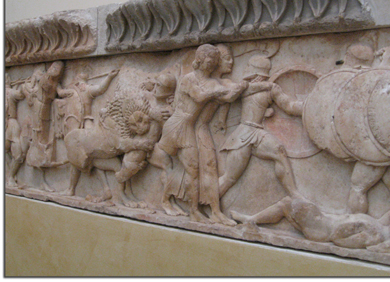 An
adjoining museum housed relics, pieces of the buildings and statues
found in the area.
An
adjoining museum housed relics, pieces of the buildings and statues
found in the area.
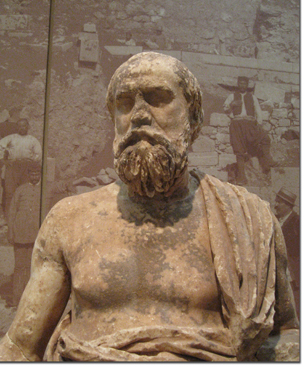
The carved detail was pretty amazing. But of course, it is all now a ruin, due to earthquakes, looting, and the weathering of the ages. Frankly, it is remarkable that so much still remains.
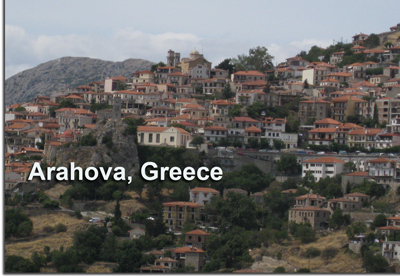
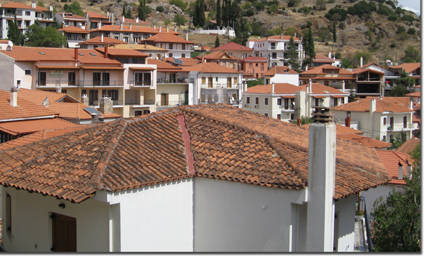 Then
we headed back to Athens, passing through the small town of Arahova on
the way. This was a little place clinging to the mountain side,
and quite prosperous due to the local ski area on nearby Mount
Parnassus. Then it was time for lunch, which as it turns out, is
the main meal of the day. Dinners are light affairs, usually
around 9:30 or 10 in the evening.
Then
we headed back to Athens, passing through the small town of Arahova on
the way. This was a little place clinging to the mountain side,
and quite prosperous due to the local ski area on nearby Mount
Parnassus. Then it was time for lunch, which as it turns out, is
the main meal of the day. Dinners are light affairs, usually
around 9:30 or 10 in the evening.
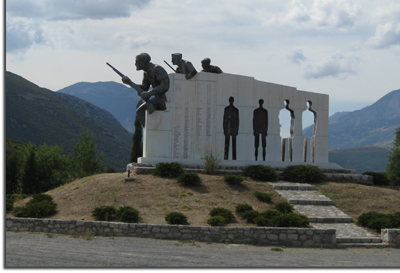
We did a brief stop at a roadside memorial honoring the Greek partisans from WW2.
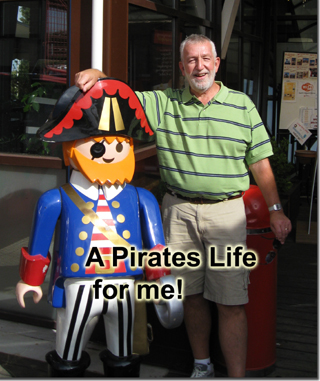 A
truck stop potty break concluded the drive back. I couldn't resist
this opportunity! We all snoozed.
A
truck stop potty break concluded the drive back. I couldn't resist
this opportunity! We all snoozed.
Our guide Babas was friendly knowledgeable, and made for a delightful day. Barb and Diana found him pretty easy on the eyes, which only added to the day.
September 4
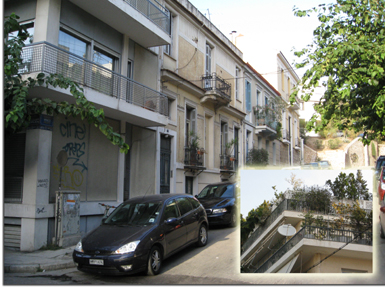 Our
time in Athens will draw to a conclusion today, as we are to board the
ship mid afternoon. First however, we had a tour of two things;
the Parthenon and the New Acropolis Museum. I walked up to the
edge of the Acropolis right after breakfast if for no other reason than
to see some additional typical streets and neighborhoods. One
thing we noticed was the amount of greenery that people had on their
balconies. There were lots and lots of plants and shrubbery on
balconies and roofs.
Our
time in Athens will draw to a conclusion today, as we are to board the
ship mid afternoon. First however, we had a tour of two things;
the Parthenon and the New Acropolis Museum. I walked up to the
edge of the Acropolis right after breakfast if for no other reason than
to see some additional typical streets and neighborhoods. One
thing we noticed was the amount of greenery that people had on their
balconies. There were lots and lots of plants and shrubbery on
balconies and roofs.
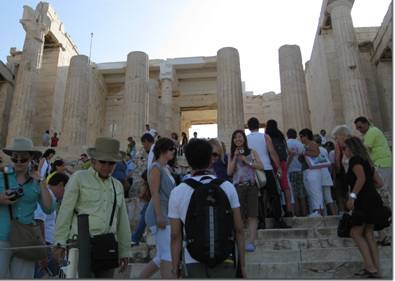
We met our guide, Mara, at the hotel, and were dropped off at the foot of the Acropolis. Then it was a long hike, again on slippery marble steps, to the top of the Acropolis, and the Parthenon. This was a light day, but there were still crowds at this, one of the world's most famous monuments.
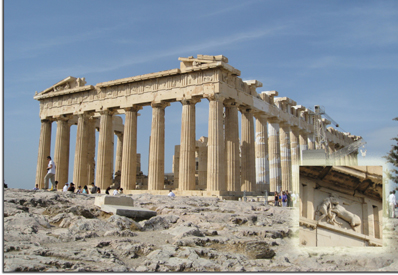 First,
let's detail a few facts about the place. The Acropolis is the
name of the hill area. Visitors will find the Parthenon, various
theaters, and other temples on the mound. The whole place is
considered to be the pinnacle of Grecian art. There are plenty of
friezes and statues to bear this out. The marble columns of the
Parthenon are made up of multiple pieces, generally formed at the
quarry, rolled to the site, and [originally] held together with a center
cedar peg. The fit was so tight that moisture could not penetrate.
British counsel Lord Elgin basically swiped some of the best carvings
from the lintels and other buildings back in the 1800, and they now
reside in the British Museum. Needless to say, there is a bit of
animosity about this. During one of the wars, a shell landed in
the middle of the building, blowing out some of the structure. The
building is tilted, so that visitors always see it at an angle, for the
full, three dimensional view. And the columns are not straight,
but tilted slightly inward to give the illusion of being straight, thus
fooling the brain into thinking they are straight (optical illusion).
It was a hike, but worth it to see this wonder of the ancient world.
First,
let's detail a few facts about the place. The Acropolis is the
name of the hill area. Visitors will find the Parthenon, various
theaters, and other temples on the mound. The whole place is
considered to be the pinnacle of Grecian art. There are plenty of
friezes and statues to bear this out. The marble columns of the
Parthenon are made up of multiple pieces, generally formed at the
quarry, rolled to the site, and [originally] held together with a center
cedar peg. The fit was so tight that moisture could not penetrate.
British counsel Lord Elgin basically swiped some of the best carvings
from the lintels and other buildings back in the 1800, and they now
reside in the British Museum. Needless to say, there is a bit of
animosity about this. During one of the wars, a shell landed in
the middle of the building, blowing out some of the structure. The
building is tilted, so that visitors always see it at an angle, for the
full, three dimensional view. And the columns are not straight,
but tilted slightly inward to give the illusion of being straight, thus
fooling the brain into thinking they are straight (optical illusion).
It was a hike, but worth it to see this wonder of the ancient world. 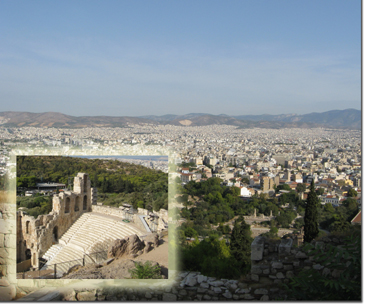
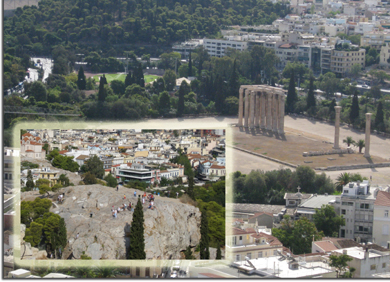 You
could also see the sprawl of Athens - it spreads for miles -as well as
what remains of the Temple of Zeus and the rock from which St. Paul the
Apostle purportedly spoke.
You
could also see the sprawl of Athens - it spreads for miles -as well as
what remains of the Temple of Zeus and the rock from which St. Paul the
Apostle purportedly spoke.
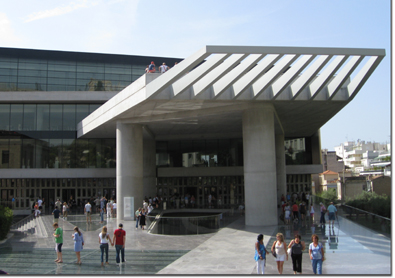
The visit to the New Museum, which is built over an archeological dig, has statues and portions of the Acropolis that had been discovered around the site. We were not allowed to take pictures, so you’ll have to visit in person to see the friezes, the portions of statuary, and other carved items. It was pretty impressive. Of course, you can’t build or dig anywhere in Athens without coming across artifacts, which makes construction a bit difficult. Projects can be held up for years if you find a few shards of pottery when you are excavating. We arrived at the ship, got into the cabin, and set sail at 1700. We are on our way through the Greek Islands. Our next stop is Mykonos.
September 5
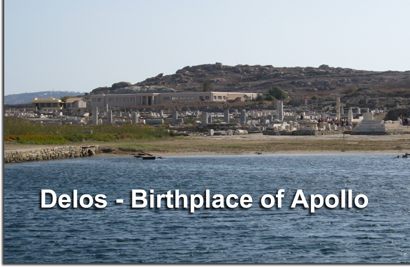 Today
we visited the islands on Mykonos and Delos. If I attempt to
relate all that we learned as saw today, I’d have to write several
pages. So I’ll attempt to hit just the highlights. It all
started when one of Zeus’s mistresses (he had a bunch) Leto was banished
by Zeus’s wife Hera. Hera chased Leto around the world, and Leto
ended up on the island of Delos, where she gave birth to Artemis and
Apollo. It was said that the entire island was bathed in light
when Apollo was born. In actuality, NASA has confirmed that the
island is one of three places on the planet that has the most sunlight.
Today
we visited the islands on Mykonos and Delos. If I attempt to
relate all that we learned as saw today, I’d have to write several
pages. So I’ll attempt to hit just the highlights. It all
started when one of Zeus’s mistresses (he had a bunch) Leto was banished
by Zeus’s wife Hera. Hera chased Leto around the world, and Leto
ended up on the island of Delos, where she gave birth to Artemis and
Apollo. It was said that the entire island was bathed in light
when Apollo was born. In actuality, NASA has confirmed that the
island is one of three places on the planet that has the most sunlight.
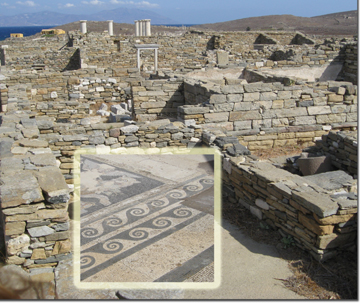
Because this was considered Apollo’s birthplace, people from all around the civilized world came to visit. So temples were built, houses constructed, and eventually the island grew into a trading post for the Greeks, the Romans and the Persians. At its height, over 30,000 people lived on the windy, rocky island. It helped that around 167 years BC, the place was considered a free trade port. It is estimated that 750,000 tons of merchandise, including slaves, passed through the port each year. The friendly relations with the Romans proved to be the downfall of the island. It was looted twice by enemies. These attacks coincided with the growth of Christianity.
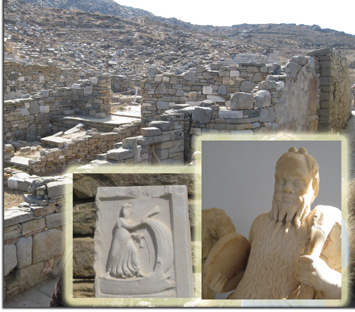 Apollo
was forgotten, trade and travel dwindled, and eventually the island was
left to ruin. The wind and earth took their gradual toll, and
buried most of the structures. Excavation started in the late 19th
century, and continues today. About 1/6th of the site
has been excavated, with some amazing glimpses into the past life on
Delos. We saw original door and window frames, tiled floors,
sewage systems, water storage systems, temples, and one of the theaters.
Because it is quite windy here, the streets were built in a winding
fashion, not only to block the wind, but to deter any invaders.
The street maze was pretty much as was found in Mykonos today.
Delos was very impressive.
Apollo
was forgotten, trade and travel dwindled, and eventually the island was
left to ruin. The wind and earth took their gradual toll, and
buried most of the structures. Excavation started in the late 19th
century, and continues today. About 1/6th of the site
has been excavated, with some amazing glimpses into the past life on
Delos. We saw original door and window frames, tiled floors,
sewage systems, water storage systems, temples, and one of the theaters.
Because it is quite windy here, the streets were built in a winding
fashion, not only to block the wind, but to deter any invaders.
The street maze was pretty much as was found in Mykonos today.
Delos was very impressive.
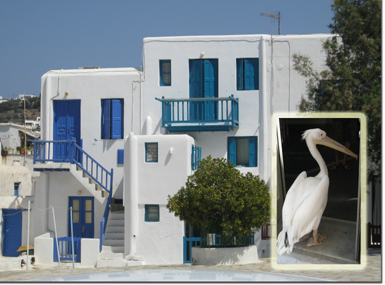
Then on to lunch back in Mykonos, and a wander through the narrow twisting streets, with views of the sea, and hills.
There are a lot of
chapels, as practically every household had someone at sea.
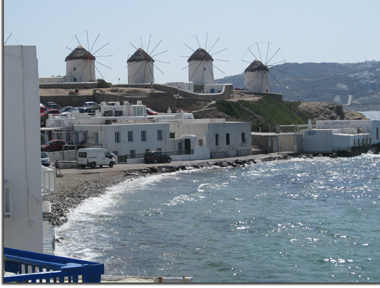 It
is a city law that all houses must be painted white, with the only color
to be in the windows and doors. Bright blue is the predominant
color, but you’ll find red, green and various shades of blue. One
of the sights not to be missed is the windmills here. Circular in
shape, they have circular fabric sails, unlike the Dutch ones we are
used to seeing with the paddle blades.
It
is a city law that all houses must be painted white, with the only color
to be in the windows and doors. Bright blue is the predominant
color, but you’ll find red, green and various shades of blue. One
of the sights not to be missed is the windmills here. Circular in
shape, they have circular fabric sails, unlike the Dutch ones we are
used to seeing with the paddle blades.
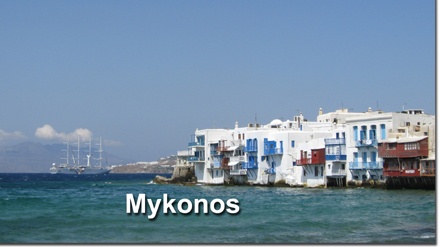
It is very, very windy. There are also many resort homes for the wealthy on the island. The big money though, is on the neighboring island of Mindos. We did not go there. We probably would have been turned away at the harbor!
We were back at the ship mid afternoon.
September 6
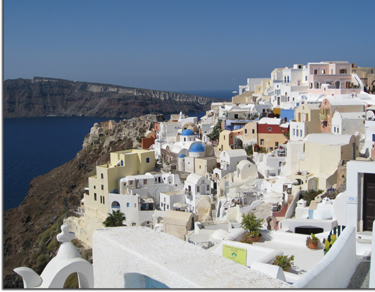 Today,
we visited Santorini, which is considered by many to be the crown jewel
of the Greek Islands. This island consists of about 80% of a
circle, as the center is a caldera, resulting from a large volcanic
eruption around 1640 BC. The island rises to a height of 1100
feet, while the water depth is about 1300 feet. The rich volcanic
soil makes for great vineyards, and of course, we sampled the local
product, which was quite good.
Today,
we visited Santorini, which is considered by many to be the crown jewel
of the Greek Islands. This island consists of about 80% of a
circle, as the center is a caldera, resulting from a large volcanic
eruption around 1640 BC. The island rises to a height of 1100
feet, while the water depth is about 1300 feet. The rich volcanic
soil makes for great vineyards, and of course, we sampled the local
product, which was quite good.
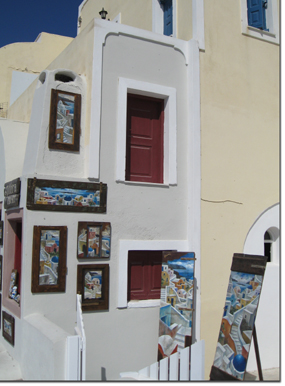
The capitol, Fira, as
well as the more picturesque town of Oia (E-ah) is filled with white
limestone washed buildings with blue domed roofs. Because
everything is so far above the water, there is plenty of climbing and
some “if this bus goes over the edge we’re all dead” roads to navigate.
Tourism is the main economy, with plenty of
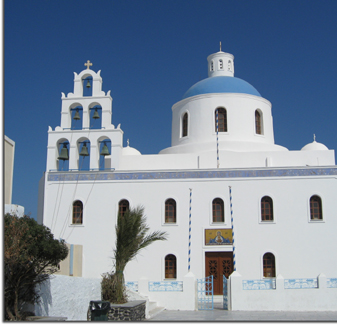 jewelry,
arts galleries, mixed into the usual T-shirt shops. Wi-Fi again
proved elusive.
jewelry,
arts galleries, mixed into the usual T-shirt shops. Wi-Fi again
proved elusive.
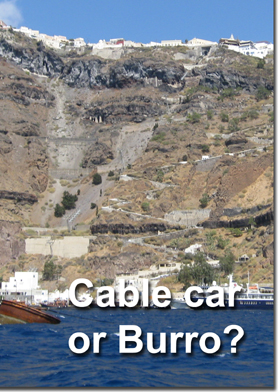
There are three ways to get to Fira from the port: walk up or down some 500 steps, ride a burro, or take a cable car. We all opted for the latter method. Tonight is the Captain’s Reception, which I’ll bet he just loves (“So who’s driving the boat?”) Tomorrow is our last stop in Greece – Rhodes.
We discovered last night that Maritime Law states that an international cruise has to touch at least two countries within a week. Known as The Jones Law, it can complicate life for tour planners, as well as employees.
September 7
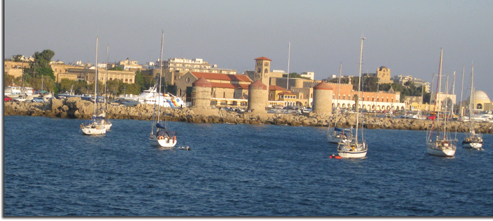 Our
destination today was Rhodes, the fourth largest of the Greek Islands,
and our final Grecian port of call. Unfortunately, the Colossus
was long gone, shattered by an earthquake, carted off and sold for
scrap. What remains in the capitol city is a walled, medieval
city.
Our
destination today was Rhodes, the fourth largest of the Greek Islands,
and our final Grecian port of call. Unfortunately, the Colossus
was long gone, shattered by an earthquake, carted off and sold for
scrap. What remains in the capitol city is a walled, medieval
city.
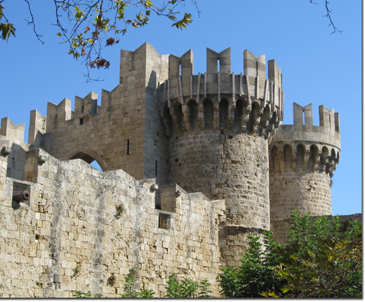 This
was a part of the Roman Empire, but languished until the 14th
century, when the Knights of St. John took control of the island.
The Knights, consisting of members from Spain, France, Italy, Germany &
England came to use the island as a base for returning Jerusalem to the
Christian fold. While many forces tried to take back the island,
it wasn’t until Suleiman II, through treachery, forced the knights off
the island.
This
was a part of the Roman Empire, but languished until the 14th
century, when the Knights of St. John took control of the island.
The Knights, consisting of members from Spain, France, Italy, Germany &
England came to use the island as a base for returning Jerusalem to the
Christian fold. While many forces tried to take back the island,
it wasn’t until Suleiman II, through treachery, forced the knights off
the island.
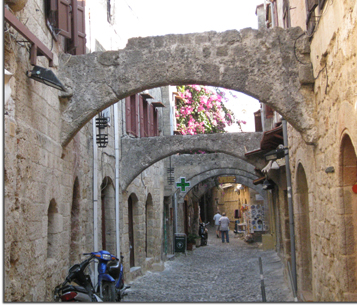
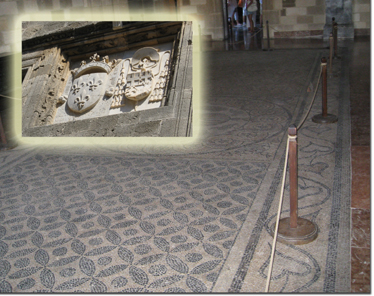
The fortress is pretty well pretty well preserved, with wonderful mosaic floors and coats of arms set into the building that housed the knights. So a palace and fortress dominate the old town, which is now a vast tourist area. We opted out of our trek to Lindos to see another Acropolis, and instead did a walking tour of the old town. Because the area is seismically active, the early buildings were all stabilized by archways over the streets. The practice continues today, over the narrow, winding passageways.
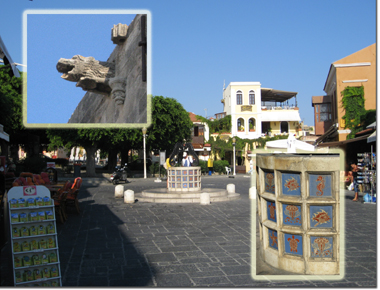
And after walking around for about 4 hours, ended up in a street café, just watching the people go past. There were plenty of little things to see, such as gargoyle rainspouts, tiles fountains, and imbedded stone reliefs. It was lovely to just sit and watch life go by.
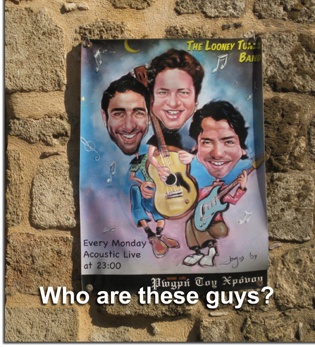
Of course, there were the usual tourist items, but that should be expected. I thought that the upcoming rock band poster was too good to leave undocumented.
We headed back to the
ship, but I later went back into town. Many of the
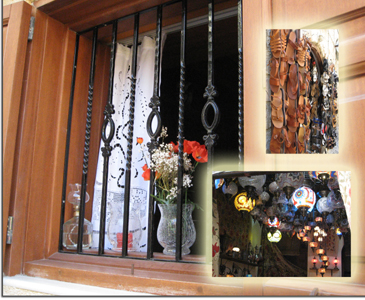 streets
have no name, and it is really pretty easy to get lost. The
streets twist and turn, dead end, and loop back on themselves.
While the tourist stuff all looked the same to me, there were a few
photographic highlights that will make me remember our time here.
streets
have no name, and it is really pretty easy to get lost. The
streets twist and turn, dead end, and loop back on themselves.
While the tourist stuff all looked the same to me, there were a few
photographic highlights that will make me remember our time here.
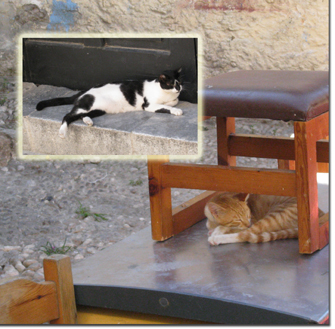
The streets are all paved with pebbles, washed up from the sea, and cats seem to rule. In fact, we saw lots and lots of cats. But not to many dogs. Like I said, cats rule.
September 8
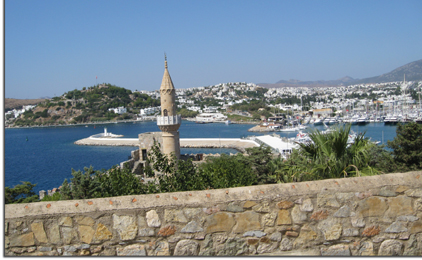 Our
journey today took us to Bodrum, our first port of call in Turkey.
It just so happens that the sister ship, the Wind Surf, was here in port
at the same time, but going in the other direction. Bodrum is a
resort city, with sparkling Aegean waters, and whitewashed houses
running up the hillsides. I think our guide said that there were
roughly 30,000 people here. The traffic certainly seemed to support
that.
Our
journey today took us to Bodrum, our first port of call in Turkey.
It just so happens that the sister ship, the Wind Surf, was here in port
at the same time, but going in the other direction. Bodrum is a
resort city, with sparkling Aegean waters, and whitewashed houses
running up the hillsides. I think our guide said that there were
roughly 30,000 people here. The traffic certainly seemed to support
that.
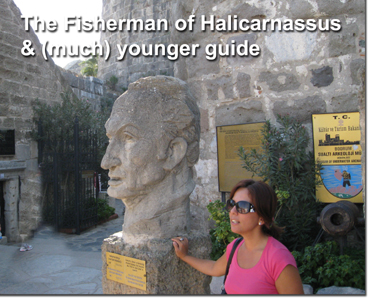
Upon entry into the city, we were greeted by one of many statues.
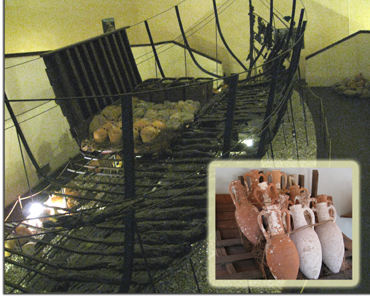
Our one visit today was to the castle, along with the Underwater Archeological Museum. It was to this castle that the Knights ended up after being forced from Smyrna in 1402. They stayed here until 1523, when Suleiman the Magnificent captured Rhodes, thus making their position here indefensible. But the big item was that this was the site of one of the seven ancient wonders, the tomb of King Mausolus. Built by his wife in 353 BC, this Mausoleum of Halicarnassus stood for better than 900 years before being destroyed in an earthquake. The town was also known for ship building and did a lively trade business. The waters around the area can be treacherous, and so shipwrecks abound. The prize of the museum was a tubby freighter (16m long, 5m beam) that was carrying what amounted to recycled glass. One of the divers who helped excavate the wreck gave us a tour, which proved quite interesting. I also learned why amphora are pointed; they stack easier that way and can absorb shock better.
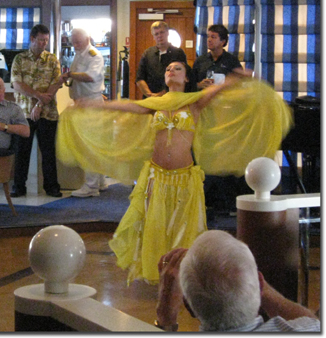
We got back to the ship in the early afternoon, and went swimming in the Aegean Sea. So that is now off our list of seas into which we have been. Tonight is a belly dancing demonstration, and the much publicized barbeque.
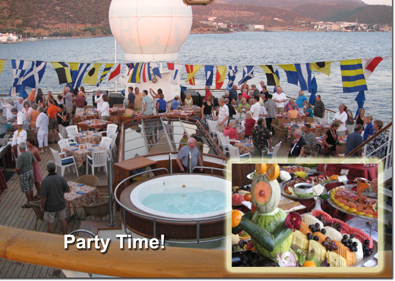
Later. The barbeque was a feast. Yikes, but what a lot of food.
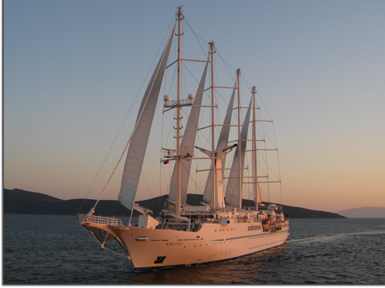
And to heighten the experience, our sister ship, the Wind Spirit, sailed around us before heading off to its next port. It was a really wonderful sight, as the setting sun caught the ship and cast it in a golden glow.
September 9
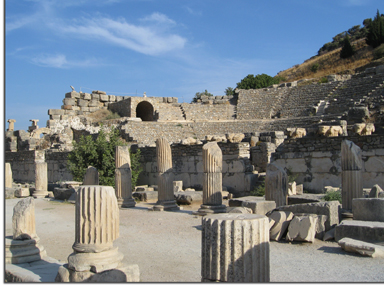 Our
stop this morning was Kusadasi, which means Bird Island. This is
now a major resort area for western Turkey, and the port of entry to
Ephesus. This ancient ruin is all that is left of a major trading
port. The place fell into decline around 1450 AD, due to silt
build up in the river delta, and an earthquake, which shifted the river
and the terrain. While the city used to be right on the sea, it is
now six miles inland. Our visit to the island of Delos offered an
initial offering as to what these archeological sites looked like.
This one was in the process of restoration. So there was some work
on rebuilding the temples, and day to day structures, as well as an
effort to get some of the statuary and carvings out into the open.
Our
stop this morning was Kusadasi, which means Bird Island. This is
now a major resort area for western Turkey, and the port of entry to
Ephesus. This ancient ruin is all that is left of a major trading
port. The place fell into decline around 1450 AD, due to silt
build up in the river delta, and an earthquake, which shifted the river
and the terrain. While the city used to be right on the sea, it is
now six miles inland. Our visit to the island of Delos offered an
initial offering as to what these archeological sites looked like.
This one was in the process of restoration. So there was some work
on rebuilding the temples, and day to day structures, as well as an
effort to get some of the statuary and carvings out into the open.
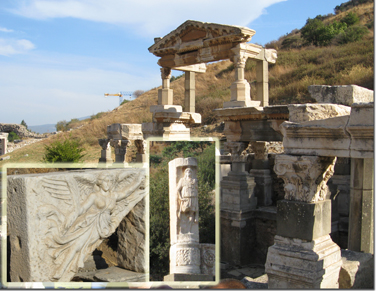
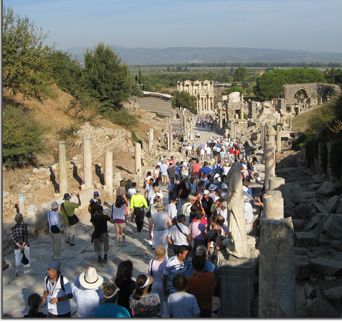
The main boulevard wasn't too crowded, but there were still a lot of people. It was paved in the usual slippery marble which made walking a bit of a arduous endeavor.
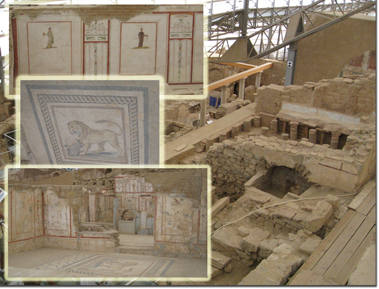 Ephesus
is the site of some well preserved terrace houses. These were
dwellings for the wealthy of the town, and featured indoor plumbing,
heating and cooling schemes, as well as indoor courtyards. The
wall paint and decorations still remain, and are equal to the beauty of
the floor mosaics. It is pretty amazing that his has all survived
for better than 2,000 years. Much has been dug out, but much
remains buried. Interestingly, there is a lot of Austrian money in
the excavation.
Ephesus
is the site of some well preserved terrace houses. These were
dwellings for the wealthy of the town, and featured indoor plumbing,
heating and cooling schemes, as well as indoor courtyards. The
wall paint and decorations still remain, and are equal to the beauty of
the floor mosaics. It is pretty amazing that his has all survived
for better than 2,000 years. Much has been dug out, but much
remains buried. Interestingly, there is a lot of Austrian money in
the excavation.
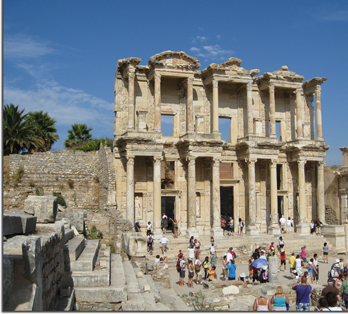
One of the largest remaining structures is the portal to the Library of Celsius. The structure and contents were destroyed in a fire. Two books just happened to be borrowed from the library that night - the Illiad and the Odyssey.
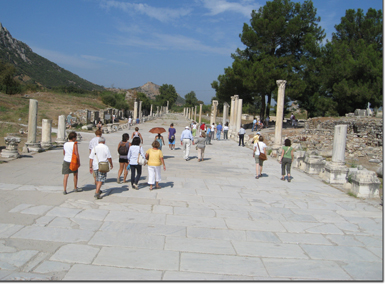
This walkway once went down to the port on the Aegean. It was rather interesting to walk on the same path that Anthony & Cleopatra walked on, and to learn that one reason the Iliad and the Odyssey were preserved was that they were checked out of the library on the night of the big fire.
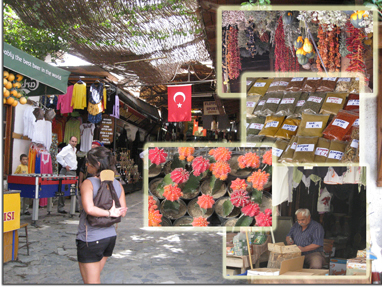
After that we had lunch in a quiet little village, Sirince, where one of our fellow passengers revealed himself as the CEO of Windstar. The time in port concluded with a carpet demonstration and chance to purchase. While the prices were extremely good, buying something like that so far from home is an issue on color, size and pattern. But there was some beautiful merchandise from which to choose. That was our final shore trip. Tomorrow we can relax, and sleep late.
September 10
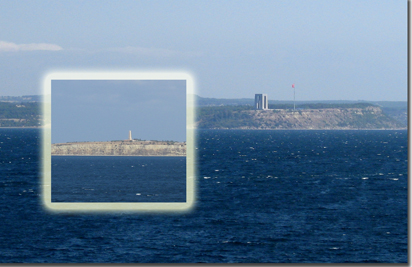 Our
day at sea was spent making our way up the Dardanelles, past Gallipoli
and into the Sea of Marmara. The Dardanelles are 38 miles long, up to
300 feet deep, and separate Europe from Asia. They have been of
strategic importance throughout history. For whoever controlled
the Dardanelles, also controlled the major trade routes to the east, and
the routes into the heart of Russia. The most recent battle of
note was the was the Gallipoli Campaign, which took place in 1915.
Lasting about eight and a half months, it cost the lives of about half a
million men. The area where the battles took place are now a
Turkish National Park, and feature three important memorials to the
Allies, the French and the Turks. Briefly, here is what happened.
During WW1, the Allies wanted to eliminate the Ottoman Empire and needed
to link the Allied troops with Russia. Churchill was Lord of
Admiralty and ordered the Royal Navy to force passage through the
Dardanelles. The Navy failed, largely due to the efforts of a
single Turkish minelayer, the Nursrat. Churchill was convinced
that the Allies needed to capture the Gallipoli Peninsula. An
expeditionary force was raised, consisting of British, French,
Australian and New Zealand troops. The idea was to make
simultaneous landing on the Peninsula and knock out the Turkish guns
guarding the waterway. In all cases, the assaults failed. Of
note is the commander of the elite 57th Turkish Regiment, one Mustafa
Kemal Ataturk, who
corrected ascertained where Allied forces would land, and
managed to defeat their assault.
Combat lasted almost nine months, and in January 1916, the Allied
survivors were evacuated.
Our
day at sea was spent making our way up the Dardanelles, past Gallipoli
and into the Sea of Marmara. The Dardanelles are 38 miles long, up to
300 feet deep, and separate Europe from Asia. They have been of
strategic importance throughout history. For whoever controlled
the Dardanelles, also controlled the major trade routes to the east, and
the routes into the heart of Russia. The most recent battle of
note was the was the Gallipoli Campaign, which took place in 1915.
Lasting about eight and a half months, it cost the lives of about half a
million men. The area where the battles took place are now a
Turkish National Park, and feature three important memorials to the
Allies, the French and the Turks. Briefly, here is what happened.
During WW1, the Allies wanted to eliminate the Ottoman Empire and needed
to link the Allied troops with Russia. Churchill was Lord of
Admiralty and ordered the Royal Navy to force passage through the
Dardanelles. The Navy failed, largely due to the efforts of a
single Turkish minelayer, the Nursrat. Churchill was convinced
that the Allies needed to capture the Gallipoli Peninsula. An
expeditionary force was raised, consisting of British, French,
Australian and New Zealand troops. The idea was to make
simultaneous landing on the Peninsula and knock out the Turkish guns
guarding the waterway. In all cases, the assaults failed. Of
note is the commander of the elite 57th Turkish Regiment, one Mustafa
Kemal Ataturk, who
corrected ascertained where Allied forces would land, and
managed to defeat their assault.
Combat lasted almost nine months, and in January 1916, the Allied
survivors were evacuated.
There was also rather a lot of freighter traffic, all of which pretty much left us in the dust.
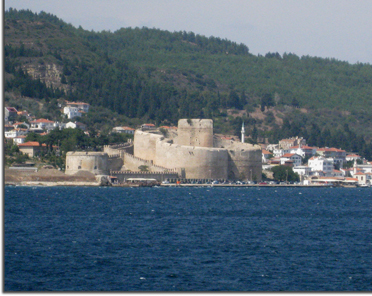
We passed Canakkale, also known as The Narrows. It was here that we found two castles, built in 1452 by Mement the Conqueror. His idea was to sling a heavy chain across the waterway, thereby blocking the strait.

Later. The weather has turned a bit, with stiff headwind and 9 foot waves. This has dropped our speed to roughly 4 knots, so the captain announced a late arrival in Istanbul. This was greeted with cheers, some of the enthusiasm no doubt alcohol fueled, but mostly by the fact that luggage collection would now begin later that 6 AM. The fun continued.
Now would be a good time to inject a bit of history of modern Turkey. Some of this applies to the actions of a young military officer, during the Battle of Gallipoli. Here is a very abbreviated history.
Until (and through) WW1, Turkey was a part of the Ottoman Empire. The Empire sided with the Germans and Austrians during the war. As previously mentioned, enter an officer from one of the Turkish military academies.
Mustafa Kemal Atatürk became known as an extremely capable military officer during WW1. After the Gallipoli he joined in the Caucasus Campaign, against Russian encroachment around 1918. The Czarist armies were defeated, and they had the Russian Revolution with which to contend.
Ataturk joined a Turkish Independence movement, and following the defeat of the Ottoman Empire, he led the Turkish national movement in the Turkish War of Independence. Having established a provisional government in Ankara, he defeated the forces sent by the Allies. His successful military campaigns led to the liberation of the country and to the establishment of modern Turkey. On 24 July 1923, the Treaty of Lausanne was signed. The final outcome of the independence war came with the proclamation of the Republic of Turkey on 29 October 1923.
During his presidency, Atatürk embarked upon a program of political, economic, and cultural reforms. In fact, he changed the entire alphabet! An admirer of the Age of Enlightenment, he sought to transform the former Ottoman Empire into a modern and secular nation state. The principles of Ataturk's reforms, upon which modern Turkey was established, are referred to as Kemalism.
September 11
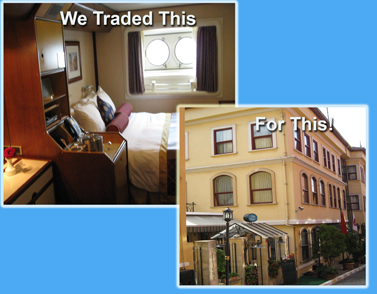 Today
was the day we were to leave the ship, and exchange hotels - a floating
room for one more stationary. We didn’t duck the early luggage
collection by much, but at least everyone had more time to eat a
leisurely breakfast, and watch the port of Istanbul come into view.
Today
was the day we were to leave the ship, and exchange hotels - a floating
room for one more stationary. We didn’t duck the early luggage
collection by much, but at least everyone had more time to eat a
leisurely breakfast, and watch the port of Istanbul come into view.
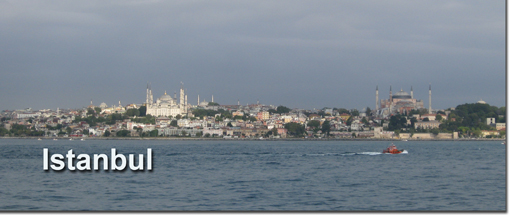
It was really quite thrilling to see the outlines of the mosques and this ancient, yet modern city come into view through the morning mists.
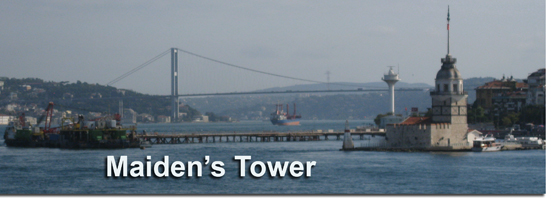 We
also passed the Maiden's Tower, which has been a shooting location in
many films. The place was built in roughly 408 BC to control ship
movements in the Bosporus. It's been rebuilt and expanded over the
centuries, used as a lighthouse and is now a popular cafe. The
most popular legend about the place concerns a sultan who had a beloved
daughter. An oracle prophesied that she would die on her 18th
birthday. The sultan locked her away on this island fortress.
Upon reaching her 18th birthday, the sultan brought her a basket of
fruit to celebrate. Hidden in the fruit was an asp, which bit and
killed the daughter, thus fulfilling the prophecy.
We
also passed the Maiden's Tower, which has been a shooting location in
many films. The place was built in roughly 408 BC to control ship
movements in the Bosporus. It's been rebuilt and expanded over the
centuries, used as a lighthouse and is now a popular cafe. The
most popular legend about the place concerns a sultan who had a beloved
daughter. An oracle prophesied that she would die on her 18th
birthday. The sultan locked her away on this island fortress.
Upon reaching her 18th birthday, the sultan brought her a basket of
fruit to celebrate. Hidden in the fruit was an asp, which bit and
killed the daughter, thus fulfilling the prophecy.
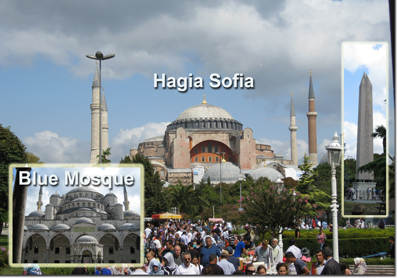
We docked and disembarked about two hours late. I called the hotel, which then sent a car for us. Initially, we thought that we were in the middle of nowhere. However, further investigation put us about three blocks from the Topkapi Palace, the Blue Mosque, and the whole Sultenahmet area. So we checked in, wandered a bit, had a light lunch, and of course, coffee in a street café.
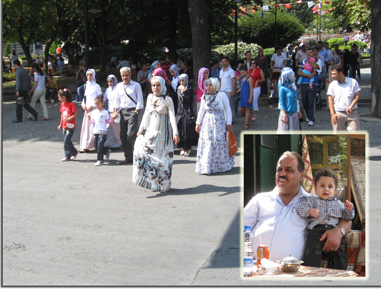
This was the final
day of the feast days that follow Ramadan, so there were lots of locals
about, strolling, eating, and just having an outing on a beautiful,
sunny day.
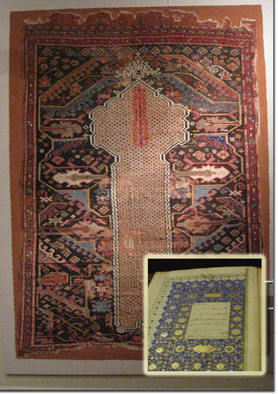
We also stopped in the Islamic art Museum, and saw some beautiful carpets, Korans, and other period items. It was dinner at the hotel, which turned out to be wonderful. The staff could not do enough for us. I think we will drink them out of Turkish vodka (pretty good) and cognac. Our formal tours start tomorrow, Sunday.
September 12
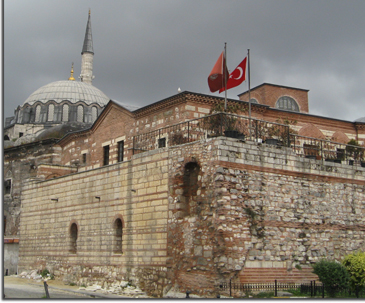 Our
luck with warm, sunshine filled days ended today. The day started
grey and rainy, and went downhill from there. On the plus side,
the wet weather did cut down on the number of tourists. Our guide
for the day, Erturk, met us at the hotel, and led us to the van, piloted
by Sammi, our driver. We left the old town, past the Roman walls,
into the new city.
Our
luck with warm, sunshine filled days ended today. The day started
grey and rainy, and went downhill from there. On the plus side,
the wet weather did cut down on the number of tourists. Our guide
for the day, Erturk, met us at the hotel, and led us to the van, piloted
by Sammi, our driver. We left the old town, past the Roman walls,
into the new city.
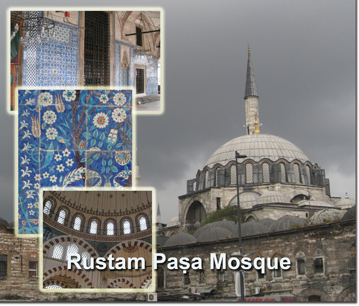 First
stop was the Rustan Pasa mosque. Built in the 16th century, this
place has better blue Iznik tiles than the Blue Mosque. The
building was indeed quite lovely, and the guide said that sometimes
stolen tiles will end up at Sotheby’s, fetching up to a quarter of a
million dollars. So security on the place is tight. (So he
said). After seeing the Blue Mosque the next day, I would concur.
This place was a little gem. Situated off the ground due to space
concerns, it is small, but definitely worth a look.
First
stop was the Rustan Pasa mosque. Built in the 16th century, this
place has better blue Iznik tiles than the Blue Mosque. The
building was indeed quite lovely, and the guide said that sometimes
stolen tiles will end up at Sotheby’s, fetching up to a quarter of a
million dollars. So security on the place is tight. (So he
said). After seeing the Blue Mosque the next day, I would concur.
This place was a little gem. Situated off the ground due to space
concerns, it is small, but definitely worth a look.
Turkey is a Muslim nation, but is a secular nation. The churches are run by the government, with clergy paid as government employees. So you don’t see the strange offshoot sects that are found in other Middle Eastern countries. About 95% of the Turkish population of 73 million is Muslim. But there is a vast difference between belonging to the religion, and practicing it. As originally designed (according to the guide), there was no intermediary between God and man; again a difference between this flavor of Islam, and that of say, Saudi Arabia or Iran where a mullah gets in the middle. While there are mullahs here they function as one, centrally directed point of view. Or so I understand it. Imagine that approach in the US!
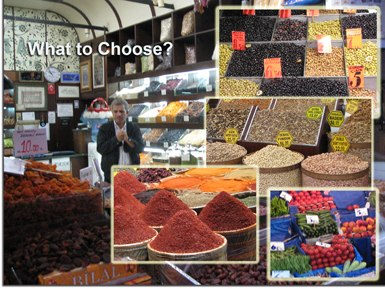
By the time we left the mosque, the wholesale portion of the spice market was open, and there were storefronts with mounds of spices, olives, nuts, cheese and other foodstuffs on display. It was quite colorful.
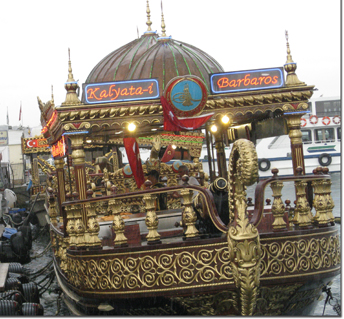 Onto
the river, we went, in the rain, past the fishmongers boats. My
first impression of this was that of a tourist party boat. It may
be visually set up for tourists, but you could see the fishermen
cleaning and gutting fish, while selling on these rocking craft.
Onto
the river, we went, in the rain, past the fishmongers boats. My
first impression of this was that of a tourist party boat. It may
be visually set up for tourists, but you could see the fishermen
cleaning and gutting fish, while selling on these rocking craft.
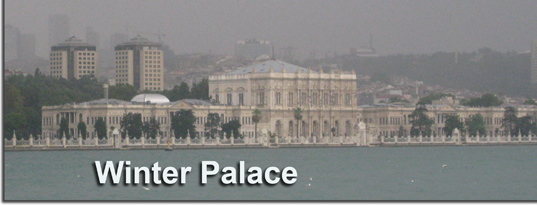 It
was then a run up the Bosporus, so 20+ miles of crowded waterfront.
The banks of Europe and Asia were filled with either old palaces, some
of which we would later visit. Dolmabahce Palace, sometimes called
the Winter Palace, was built between 1843-56. This sprawling
complex was on the site of what was originally a small, shallow bay,
which was perfect for anchoring the Ottoman fleet. The place is
huge, at over 110,000 square meters, on 250,000 square meters of land.
Ataturk, the Father of modern Turkey, died in this palace on November
10th, 1938, and the place was converted to a museum in 1952. We
did not have time for a tour, but the write-ups on the place make it
sound like you could easily spend a day here.
It
was then a run up the Bosporus, so 20+ miles of crowded waterfront.
The banks of Europe and Asia were filled with either old palaces, some
of which we would later visit. Dolmabahce Palace, sometimes called
the Winter Palace, was built between 1843-56. This sprawling
complex was on the site of what was originally a small, shallow bay,
which was perfect for anchoring the Ottoman fleet. The place is
huge, at over 110,000 square meters, on 250,000 square meters of land.
Ataturk, the Father of modern Turkey, died in this palace on November
10th, 1938, and the place was converted to a museum in 1952. We
did not have time for a tour, but the write-ups on the place make it
sound like you could easily spend a day here.
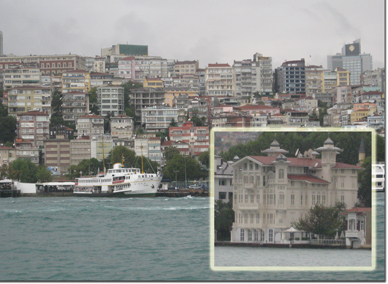
In addition to the royal residences, there were many modern palaces as well; or newer, obviously very pricey homes. Location, location, and some of these were well situated. I never have given much thought to housing along the waterway. Some of these places were fabulous. And judging from the yachts (with their helicopters on the afterdeck) the prices are substantial.
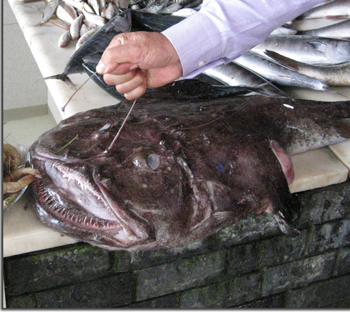
Sammi met us at the last port of call before the Black Sea (so we can say we have seen that body of water), and we headed for a local fish restaurant. While we all had sea bass, Barb, the beef eater, did not care for hers. She, like the rest of us, was fascinated with the lantern fish. I’ve seen photos, but never the real thing. My, what big teeth you have! And my, you certainly are ugly. We were told that these fish are very good to eat. I don't know. Hopefully, they don't serve it whole, on the plate!
It was rather nice sitting under cover, listening to the hard rain, and watching the lightening on the Bosporus.
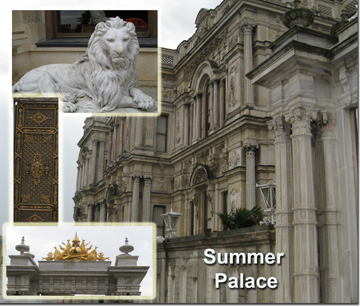
Beylerleyi Palace was next. Built as a summer residence in 1861-1865, the place was primarily used to entertain visiting heads of state. Just a little summer place, it was lovely, with an indoor fountain, inlaid wood, and impressive rooms. No photos were allowed, so you’ll have to take my word for it. Incidentally, we were told that construction of these two palaces did much to bankrupt the country and helped to force the end of the Ottoman Empire in 1923.
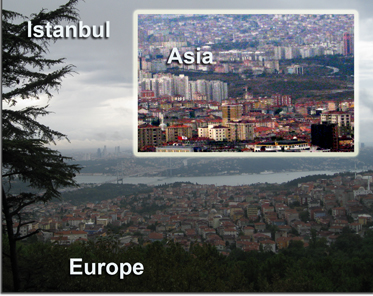
Off to Pine Hill, for an overview of the area. It was rather neat to see both Europe, and Asia just by turning around. Fortunately, the rain abated just enough that we could see both areas of the sprawling city. The guide said that the Asian side was primarily housing, while the city center was on the European side.
Even though it was Sunday we were then back into the heavy traffic to get to the European side.
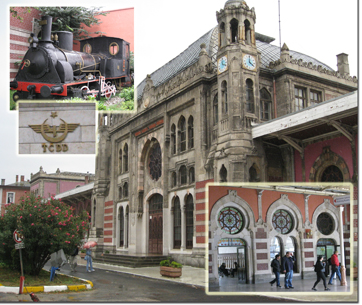
A stop at the train station completed the day. This was the last stop for the famed "Orient Express." While there wasn't much of a museum here (the guide book said there was), it must have been very mysterious to get off the train at this station. While there have been many upgrades, some of the old station still remains.
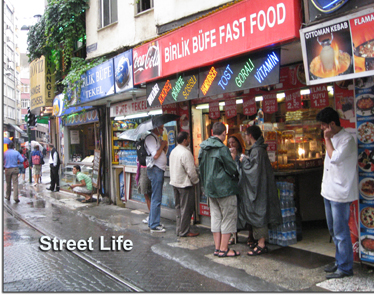
The rain didn't stop street traffic though. People were still out and about.
September 13
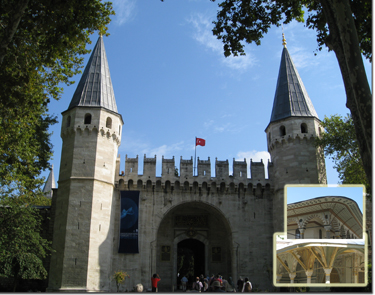 While
our guide yesterday just sort of dialed in the day, our boss for the day
was a delight. Mahmet is 42, has traveled extensively, and showed
us a great time. First stop was Topkapi Palace, the home of the
Sultanate. The kitchens fed 3,000 people a day, to give you an
idea of the staff and personnel needed to run this 70,000 square foot
establishment. We saw the crown jewels, religious artifacts, and
other highlights of the palace. You could take all day here, but what
we saw was enough for us.
While
our guide yesterday just sort of dialed in the day, our boss for the day
was a delight. Mahmet is 42, has traveled extensively, and showed
us a great time. First stop was Topkapi Palace, the home of the
Sultanate. The kitchens fed 3,000 people a day, to give you an
idea of the staff and personnel needed to run this 70,000 square foot
establishment. We saw the crown jewels, religious artifacts, and
other highlights of the palace. You could take all day here, but what
we saw was enough for us.
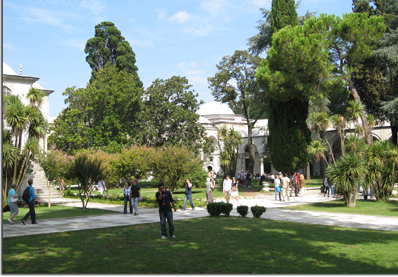
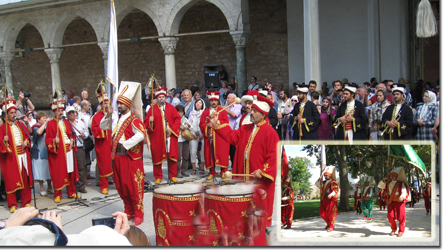
On the way out, we were fortunate enough to see the Turkish Military Band, which was playing a short concert. Apparently they travel worldwide, but only play here three or four times a year.
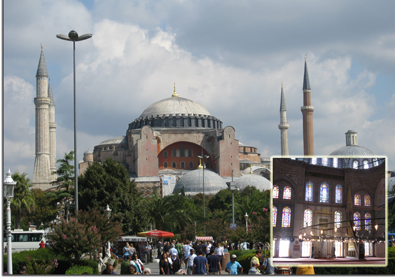
Then we were off down the street to the Blue Mosque. Built in only 7 years, it is extensively decorated with special blue Iznik tile. Personally, I think that the mosque yesterday was more colorful, but this one gets all the press.
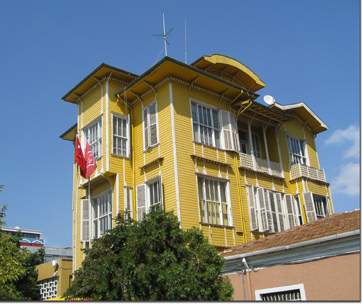 Next
was a stop at the porcelain shop, where we all succumbed to bowl and
tile purchases. I couldn't resist a photo of this old wooden
building. Later, I discovered that it was the police headquarters!
Next
was a stop at the porcelain shop, where we all succumbed to bowl and
tile purchases. I couldn't resist a photo of this old wooden
building. Later, I discovered that it was the police headquarters!
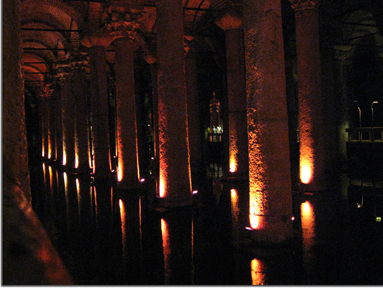 Then
we visited the underground cisterns, an often overlooked sight. On
the seven hills of Istanbul, the Romans built seven big cisterns.
These in turn fed 150 smaller cisterns throughout the city. The
large ones were fed from stepped pools and piping and aqueduct systems
from the mountains north of the city. The cisterns are supported
by columns of Greek temples. These, due to war and earthquakes,
were just lying around, begging to be used. Surface runoff
(rainwater) was filtered through sand and charcoal and fed to these
water reservoirs. Fish were used to keep the water clean, and
could still be seen today. It was pretty impressive. And for
you film lovers, a portion of "From Russia with Love," the James
Bond film, was shot here. We walked down some busy streets to a
carpet store, where we did not succumb. Then off to lunch in a
street café. It was a busy, busy street. Where are all these
people going? They weren't all tourists.
Then
we visited the underground cisterns, an often overlooked sight. On
the seven hills of Istanbul, the Romans built seven big cisterns.
These in turn fed 150 smaller cisterns throughout the city. The
large ones were fed from stepped pools and piping and aqueduct systems
from the mountains north of the city. The cisterns are supported
by columns of Greek temples. These, due to war and earthquakes,
were just lying around, begging to be used. Surface runoff
(rainwater) was filtered through sand and charcoal and fed to these
water reservoirs. Fish were used to keep the water clean, and
could still be seen today. It was pretty impressive. And for
you film lovers, a portion of "From Russia with Love," the James
Bond film, was shot here. We walked down some busy streets to a
carpet store, where we did not succumb. Then off to lunch in a
street café. It was a busy, busy street. Where are all these
people going? They weren't all tourists.
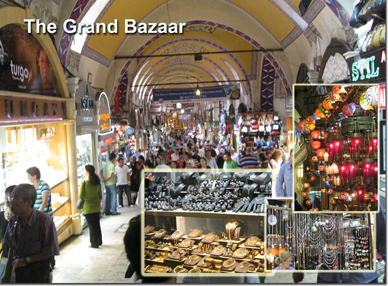
And finally we entered the Grand Bazaar. This place was unbelievable. There were shops for everything. It is a giant warren of narrow storefronts selling everything imaginable – clothes, jewelry, shoes, antiques, paintings, souvenirs, carpets, medals, watches, etc. I rubbed three different Turkish lamps, but alas, no genie appeared. Dead tired, we are back at the hotel, awaiting the Whirling Dervish show tonight. Later.
The Sufi religion is the main religion that spawned the so called "Whirling Dervishes." The participants believe the twirling can put you in a trance and thus connect you closer to God. So we basically went to a religious service, which consisted of music, and, well, twirling, costumed men. This was not exactly a highlight, but was interesting none the less.
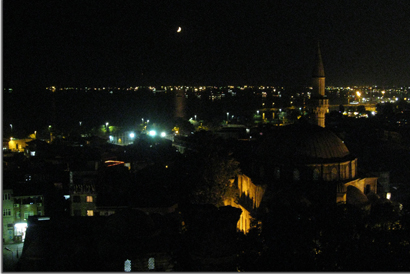
What was a highlight, was dinner on a rooftop restaurant. A crescent moon hung in the sky, and we overlooked the Bosporus. The lighted minarets reached toward the sky. It was a special moment.
September 14
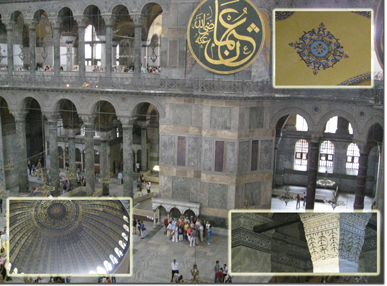 Today
was what we refer to in travelese as “free time.” So we started
late, and finished early. But that doesn’t mean we sat around.
We started by walking up to the Hippodrome and stopping at the traveling
exhibit. This was called “1001 Inventions” and detailed
contributions made by the Arabic world to science, medicine, and
technology. So we saw some things like an ingenious Elephant
Clock, early astrolabes, and surgical instrument designs that are still
being used today. Then it was on to the Haghia Sophia Museum which
was used throughout the centuries as a mosque, and as a Christian
church. Needless to say, there were the usual hordes of tourists.
We struggled up ramps to the second floor, on a winding path that never
seemed to end. In reality, it was rather like looking down on
Union Station.
Today
was what we refer to in travelese as “free time.” So we started
late, and finished early. But that doesn’t mean we sat around.
We started by walking up to the Hippodrome and stopping at the traveling
exhibit. This was called “1001 Inventions” and detailed
contributions made by the Arabic world to science, medicine, and
technology. So we saw some things like an ingenious Elephant
Clock, early astrolabes, and surgical instrument designs that are still
being used today. Then it was on to the Haghia Sophia Museum which
was used throughout the centuries as a mosque, and as a Christian
church. Needless to say, there were the usual hordes of tourists.
We struggled up ramps to the second floor, on a winding path that never
seemed to end. In reality, it was rather like looking down on
Union Station.
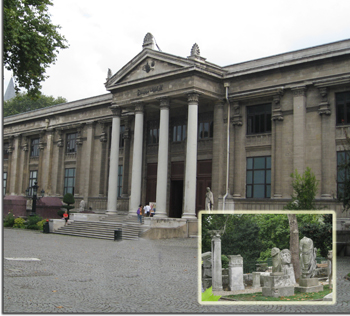
Lunch at the Four Seasons was next. The hotel converted a Turkish prison into a wonderful place to stay and relax. Final stop for the day was the Archeological Museum. If you wanted to see a lot of statuary, wall reliefs, and early historical finds, then this was the place. There was so much of it that the court yard was filled with additional pieces.
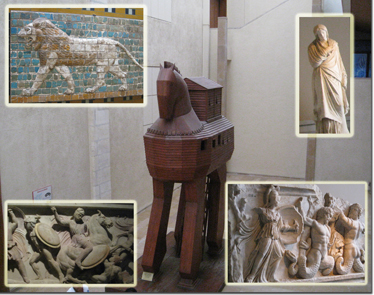
You could see the sarcophagus of Alexander, and lion reliefs from the walls on the road to Babylon.
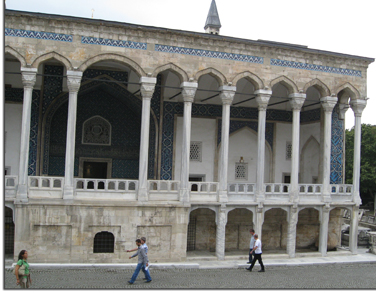
One building, the Tile Pavilion, featured lots of dark blue tile in the interior rooms. And then we did what we always like to do – stop at a street café and have coffee.
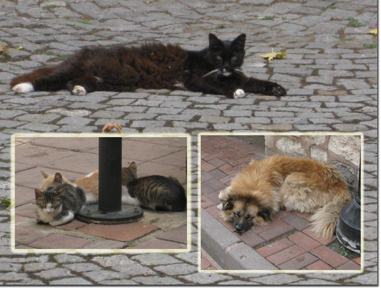
We again saw more cats. Cats seem to rule around here. There were many more of them than dogs.
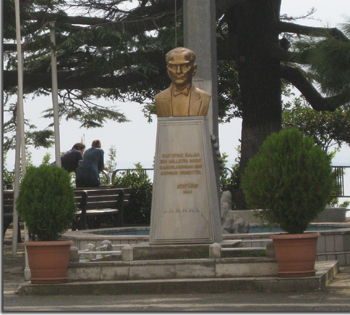
Wandering back to the hotel, we passed the grounds of a university, with the statue of Kemal Ataturk. I thought I should at least have one shot of him, commemorating our stay in Istanbul.
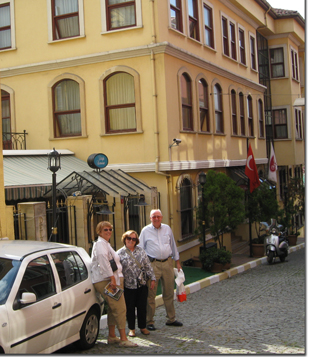
From there it was a short walk back to the Arena Hotel, and with its helpful staff. A word about our hotel is in order. Is this the Four Seasons? No, it isn’t. But it is a delightful, charming boutique hotel, located very close to all the tourist attractions in the Sultanahmet Area. The staff is delightful, there is a Turkish bath (which we did not use), and the restaurant is pretty good. And the prices are quite reasonable. If you decide to come to Turkey, check out this place, which is actually a converted private home. The name again is the Arena Hotel. We will be sad to leave, but home beckons, even if it does so at 0200 Wednesday morning. It’s been a great trip, with many wonderful memories. It is quite eye opening in terms of culture, religion, and enlightenment.
September 15
We were out of the hotel in the middle of the night, and driven to the airport, which is large and quite modern. The day went downhill from there, as it was the endless plane ride, in coach, with people tipping their seats into your face. I have to get a job where I make enough to fly business all the time. We arrived in Chicago pretty much on time, and then, as Dorothy said, "There's no place like home."